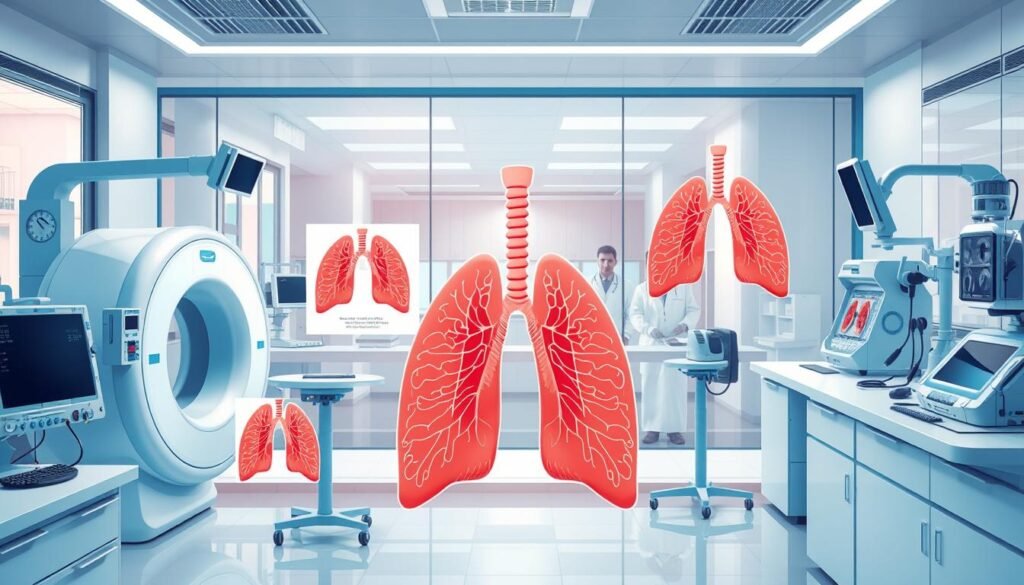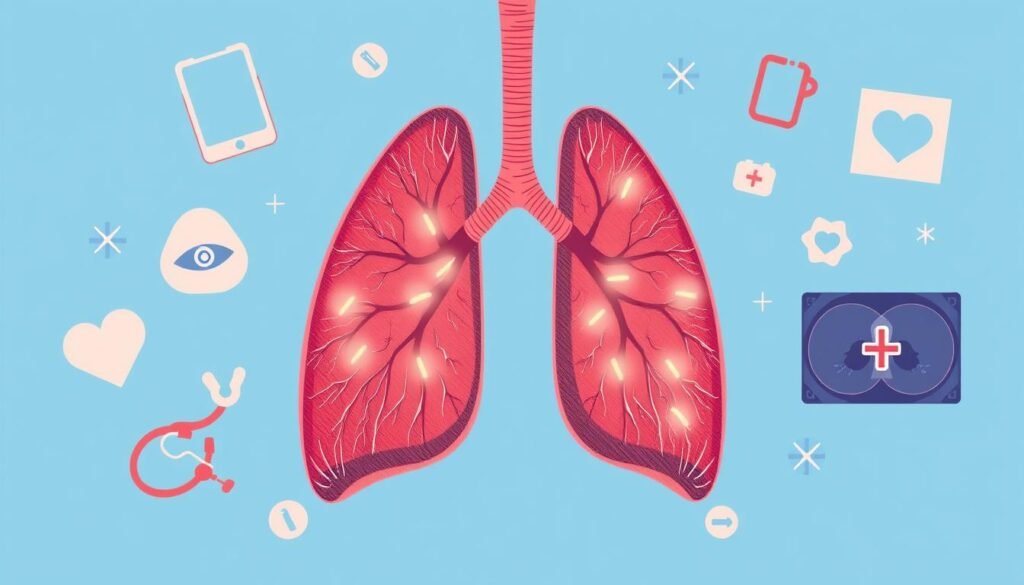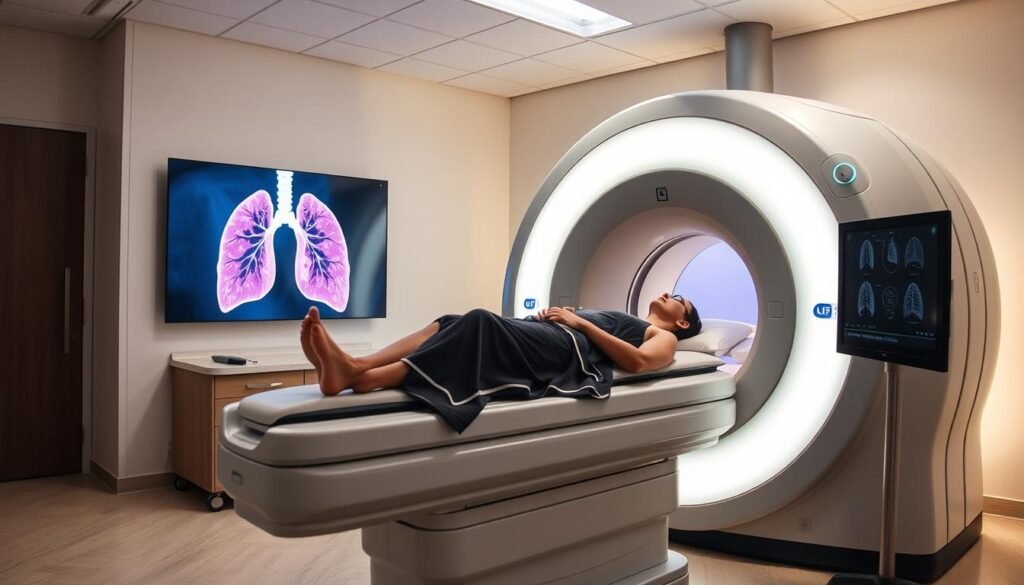About 70% of lung cancers are found late. Early detection greatly increases survival chances for those at risk. If you have a history of smoking, understanding lung tests is essential. Lung cancer is a top cause of cancer deaths in the U.S. So, it’s vital to focus on screenings.
There are many lung tests for early cancer detection. These tests, like low-dose CT scans, are key in diagnosis. They also check your overall health. Advances in tech have improved tests like x-rays and CT scans. These tests now better find lung tumors early. Also, help on quitting smoking is very important.
For more info on lung cancer screening, check the American Cancer Society. Knowing more and being proactive can lead to early detection. This may save lives.
Key Takeaways
- Early detection of lung cancer significantly increases treatment success and survival rates.
- Lung cancer screening is especially critical for individuals with a history of smoking.
- Low-dose CT scans are highly effective in identifying lung tumors, more so than traditional chest x-rays.
- Regular screenings can lead to early diagnosis of conditions that may not yet be symptomatic.
- Consultation on smoking cessation is often necessary for individuals undergoing lung cancer screening.
Introduction to Lung Cancer and Screening
Lung cancer is the top cause of cancer deaths in the United States. It’s also the second most common non-skin cancer. About 90% of cases in men and 80% in women are linked to smoking. Spotting symptoms early, like ongoing coughs, breathing trouble, and tiredness, is key for better treatment results.
Lung cancer screening with low-dose CT scans helps find the disease early. It looks for cancer before symptoms start. Studies show that screening lowers the risk of dying from lung cancer for heavy smokers. People over 50, especially those who stopped smoking in the last 15 years, are urged to get screened.
It’s crucial to know lung cancer’s stages for the right treatment. The stages go from 1 to 4. Stage 1 means small tumors that haven’t spread much. Higher stages show the disease has spread more. Detecting lung cancer early through screening boosts the success of treatment for at-risk individuals.
Importance of Early Detection in Lung Cancer
Finding cancer early is key to better survival chances for lung cancer patients. Sadly, only 21% of lung cancers are found at stage I. This shows how hard it is to detect lung cancer early. Knowing symptoms and screening options helps catch lung cancer sooner.
The US Preventive Services Task Force (USPSTF) says adults 50 to 80 who smoked a lot should get checked every year. The Centers for Medicare & Medicaid Services (CMS) agree to pay for checks that follow these rules. Following the National Comprehensive Cancer Network® (NCCN®) advice also helps find lung cancer early.
Still, not everyone gets screened as advised. Only half of those who should get checked for colorectal cancer do. This is much lower than the 80% of women who get mammograms. Low-dose CT scans are important for finding lung cancer early. They could reduce deaths from lung cancer by 20-25% compared to x-rays.
Getting to screening locations can be hard for many. Over 36% in high lung cancer areas travel far for screening. More awareness of lung cancer and early detection could improve survival. If you’re unsure about getting screened, talk to a doctor. Often, health insurance doesn’t cover screenings unless you meet certain criteria.
More awareness about early detection and screening can save lives. It’s vital to know when to get urgent care. Symptoms like fever, weight loss, and chest pain may be serious. For more on urgent symptoms, see this resource.
Understanding Lung Tests for Cancer
Finding lung cancer early can greatly improve the chances of successful treatment. Lung tests are key in spotting problems early on. There are different tests for lung cancer, each with a unique role in diagnosis.
Types of Lung Tests
There are several kinds of tests used to find and diagnose lung cancer. Here is a list of these tests:
- Low-Dose CT Scans: This test is suggested for people who have smoked a lot. It gives detailed lung images.
- X-rays: This is often the first test done. It can show spots or tumors in the lungs.
- PET Scans: These are good for finding tumors over 8 mm in size. They also show if cancer has spread.
- MRI Scans: This test checks if lung cancer has moved to the brain or nearby areas.
- Ultrasounds: Ultrasounds help see fluid around the lungs. They are useful during biopsies.
- Biopsies: Biopsies are crucial for getting a correct diagnosis. They take tissue samples for lab testing.
- CT Scans: CT scans show the size and place of tumors. They also check lymph nodes for changes.
- Bone Scans: Done when there’s bone pain, suggesting cancer may have spread.
- Endoscopies: These tests take tissue samples from the lungs.
How Lung Tests Help in Early Detection
Lung tests are not only important for confirming a diagnosis. They are crucial for finding lung cancer early. Using images from CT and PET scans, doctors can see the tumors. They can figure out their size and if they’ve spread. Checking suspicious spots through biopsies and endoscopies helps doctors understand the cancer better. This way, they can make treatment plans that are just right for the type of lung cancer found. This shows how vital these tests are in helping patients get better.

| Type of Lung Test | Primary Purpose |
|---|---|
| Low-Dose CT Scan | Routine screening for at-risk populations. |
| X-ray | Initial imaging assessment for lung issues. |
| PET Scan | Assessing cancer spread to lymph nodes. |
| MRI Scan | Checking for brain metastasis. |
| Ultrasound | Guiding biopsies and evaluating fluid buildup. |
| Biopsy | Definitive diagnosis of lung cancer. |
Lung Cancer Screening Guidelines
Lung cancer is a top cause of cancer deaths in the United States. In 2020, around 228,820 new cases were reported and about 135,720 deaths. Knowing who should be screened is crucial. Guidelines from top organizations identify who is at risk, highlighting early detection’s role.
Who Should Be Screened?
The guidelines suggest yearly scans using low-dose computed tomography (LDCT) for people 50 to 80 years old with a heavy smoking history. To be specific, those with a 20 pack-year smoking history are candidates for screening. It’s vital to know that individuals who quit smoking more than 15 years ago usually don’t need screening. Health profiles differ, so talking with a doctor to see if screening fits is important.
Recommendations by Health Organizations
The American Cancer Society and the US Preventive Services Task Force back these screening guidelines. The American Cancer Society encourages annual screenings for healthy people 55 to 74 years old who have smoked for 30 pack-years. This applies whether they smoke now or quit in the last 15 years. These recommendations aim to catch lung cancer early, improving survival chances. For more on early detection, visit this resource.

Low-Dose CT Scans for Lung Cancer
Low-dose CT scans, known as LDCT, are key in lung cancer screens for those at high risk. Studies show they’re much better than old chest X-rays in reducing deaths from lung cancer. The American Cancer Society says using LDCT widely could save up to 60,000 lives each year in the U.S.
The NELSON trial was a big study over ten years with more than 15,000 people. It found a big drop in lung cancer deaths—33% for women and 24% for men, with LDCT screens. These results make it clear that LDCT should be part of regular lung cancer checks.
When we talk about safety in cancer screens, LDCT stacks up well. A regular CT scan uses about 7 mSv of radiation, but LDCT cuts this down to just 1.4 mSv. This makes LDCT a safer choice for often testing.
LDCT tests are quick and let doctors check more often. This raises the odds of finding tumors early. Catching cancer early can hugely improve survival rates. For instance, early-stage lung cancer patients have a five-year survival rate of over 75%. But this drops to below 5% for late-stage patients.
However, LDCT has its downsides, like radiation risk and the worry of false alarms. False positives are when tests show a problem that isn’t really there. These can happen in 9.6% to 28.9% of first-time LDCT screens, causing unnecessary worry and tests.

It’s very important to be careful when looking at LDCT results. A positive means something’s there that needs a closer look. A negative result means nothing worrisome was found. Sometimes, results aren’t clear and more tests are needed. In the end, LDCT is a vital tool for lung cancer screening. It balances early detection with keeping patients safe and careful.
| Statistic | Detail |
|---|---|
| Radiation Exposure | LDCT: 1.4 mSv, Standard CT: 7 mSv |
| Mortality Reduction (Women) | 33% in NELSON trial |
| Mortality Reduction (Men) | 24% in NELSON trial |
| False Positive Rate | 9.6% to 28.9% for LDCT |
| 5-Year Survival Rate (Stage 1A) | Above 75% |
| 5-Year Survival Rate (Stage 4) | Below 5% |
Other Lung Tests: Sputum Cytology and Bronchoscopy
Looking for early signs of lung cancer involves different types of tests. Sputum cytology and bronchoscopy are important because of their unique ways to diagnose. They are key in finding out if someone has lung cancer early.
What is Sputum Cytology?
Sputum cytology checks the mucus you cough up from your lungs. It looks for abnormal cells that might mean you have lung cancer. This test can pick up tumors earlier than X-rays in some cases. For those at high risk, it found cancer in 9% of patients.
Though not as good for finding a type called lung adenocarcinoma, it’s great for spotting squamous cell carcinoma. It hardly ever gives a false positive. That makes it a go-to test when there’s a chance of lung cancer.
How Does Bronchoscopy Work?
Bronchoscopy lets doctors see inside your airways directly. They use a thin tube with a camera that goes through your nose or mouth. It’s not just for looking – they can also take small samples of tissue to test for cancer.
Some special methods, like autofluorescence bronchoscopy and navigational bronchoscopy, make this procedure even better. They help doctors see cancerous cells that are usually hard to find. Robotic bronchoscopy can get to tough spots, making biopsies more successful.
For deeper understanding of how sputum cytology and bronchoscopy work in screening for lung cancer, here’s a detailed guide.
Advanced Testing: Molecular Testing and Biomarker Testing
Advanced testing is crucial in lung cancer care, especially with molecular testing for lung cancer and biomarker testing. These tests find specific changes in cancer cells. This helps create treatments just for you.
Molecular testing for lung cancer looks at genes to find what makes cancer grow. It’s key for people with advanced non-small cell lung cancer (NSCLC). By understanding your genes, doctors can pick the best treatment. There are many genetic tests, all part of biomarker testing.
Biomarker testing helps choose the right treatment. It checks for things like ALK, EGFR, and KRAS in your tumor. Knowing these helps pick treatments that work best for you.
Choosing treatments with biomarker testing improves results greatly. For late-stage NSCLC, it helps doctors use precision medicine. This way, treatment fits your genetic profile closely. This can make treatment more successful.
Methods like biopsies and blood tests help in biomarker testing. They look for changes in your DNA and proteins. This guides your treatment plan. It helps find what works and what doesn’t. It can also show if your family is at risk for similar issues.
Biomarker testing is vital in lung cancer treatment. It helps find the best treatment plans, improving care and guiding decisions. To learn more about these tests, check out this research article.
Caregivers and healthcare providers highlight the need to know about lung cancer biomarkers. It’s a key part of your treatment. Talking regularly with your doctor about new research keeps you in the loop.
Risks and Benefits of Lung Cancer Screening
Lung cancer screening offers both good and bad points. Understanding the risks of lung cancer screening helps people make smart health choices. The benefits stand out, especially for those at high risk. Let’s look into potential problems and the clear gains of catching it early.
Potential Risks of Lung Cancer Tests
Low-dose CT scans are key in finding cancer early. But, they carry risks. About 12-14% of first screenings may falsely suggest cancer. This can lead to worry and extra tests. Roughly 6% of these scans show incidental findings, causing more unneeded checks. Over time, regular screening lowers this to about 2%.
Screening exposes you to as much radiation as six months of natural background radiation. New tech aims to cut down wrong positives and overdiagnosis. Sometimes, doctors find slowly growing nodules that need more tests. This highlights why it’s crucial to know what comes next.
Benefits of Early Screening
The value of finding cancer early is immense. Studies show that low-dose CT scans drop lung cancer death rates by at least 20% in high-risk folks. Screening catches more than half of lung cancers early. This greatly boosts survival rates. Without screening, only about 25% get caught early.
Certain people, especially those 50-80 years old with a big smoking history, have a higher chance of being diagnosed through screening. The odds of finding lung cancer in high-risk groups are 2-3% with the first scan. This offers a better shot at effective treatment. For more on early detection and symptoms, visit this link on spotting warning signs.
| Aspect | Details |
|---|---|
| False Positive Rate | 12-14% in initial tests |
| Incidental Findings | 6% for initial scans, 2% for continued screening |
| Radiation Exposure | Equivalent to 6 months of natural background radiation |
| Reduction in Mortality | 20% lower mortality among high-risk populations with LDCT |
| Early Detection Rate | Over 50% of lung cancers detected early with screening |
Conclusion
Lung tests for cancer are key in finding lung cancer early. This disease takes more than 361 lives each day in the United States. With a diagnosis every two minutes, the need for quick screening is clear. Yearly low-dose CT scans can lower lung cancer death rates by about 20%. This could add 500,000 more years to people’s lives if everyone who should get screened did.
However, in 2022, only 16% of those who should get screened actually did. This shows we must boost awareness and get more people to talk to their doctors about early detection. The national survival rate has been getting better over the last five years thanks to early screening.
We should push for regular lung screenings to improve survival and life quality. It’s really important for those at high risk, like older adults and smokers, to know their options and get screened. Being proactive not only saves lives but also helps save money on healthcare. It shows how crucial early action is in battling lung cancer.